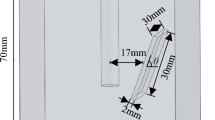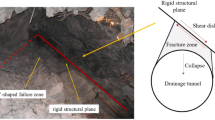Abstract
Rockburst is a safety problem that needs to be solved urgently in deep rock and mineral exploitation. The stress gradient is an important factor affecting rockburst. To explore the influence mechanism of stress gradient on rockburst, the loading and unloading tests of rockburst physical model under different stress gradients are carried out using the self-developed gas–liquid composite rockburst test device. Based on the strain test results of rockburst model, the spatial distribution characteristics of elastic energy are analyzed. The particle size distribution characteristics and throwing kinetic energy of debris after the rockburst of model are studied. The following conclusions are obtained: (1) the value of the stress gradient coefficient m reflected by the strain within the range of the model loading rockburst gradient 1 affects the temporal and spatial distribution of energy release process; (2) With the increase of the vertical loading stress gradient, the rockburst debris gradually changes from large plate debris to small flake, block and powder debris. The maximum ejection distance of rockburst debris gradually increases, and the dynamic failure phenomenon of rockburst becomes more and more obvious; (3) As the loading stress gradient increases, the throwing kinetic energy of rockburst debris per unit mass shows an increasing trend. The research results are of great significance to tunnel safety construction and rockburst early warning.
Highlights
-
The stress gradient is an important factor affecting rockburst in deep rock mass engineering.
-
The value of the stress gradient coefficient affects the temporal and spatial distribution of energy release process.
-
As the loading stress gradient increases, the rockburst debris gradually changes from large plate debris to small flake, block and powder debris.
-
With the increase of the stress gradient, the maximum ejection distance of debris gradually increases, and the dynamic failure tends to be severe.












Similar content being viewed by others
Data availability
The data that support the findings of this study are available on request from the corresponding author. The data are not publicly available due to privacy or ethical restrictions.
References
Akdag S, Karakus M, Taheri A, Nguyen G, Manchao H (2018) Effects of thermal damage on strain burst mechanism for brittle rocks under true-triaxial loading conditions. Rock Mech Rock Eng 51(6):1657–1682
Camones LAM, do Amaral Vargas Jr E, de Figueiredo RP, Velloso RQ (2013) Application of the discrete element method for modeling of rock crack propagation and coalescence in the step-path failure mechanism. Eng Geol 153:80–94
Caputa A, Rudziński Ł (2019) Source analysis of post-blasting events recorded in deep copper mine. Poland Pure Appl Geophys 176(8):3451–3466
Collins BD, Stock GM, Eppes MC (2019) Relaxation response of critically stressed macroscale surficial rock sheets. Rock Mech Rock Eng 52(12):5013–5023
Faradonbeh RS, Taheri A, e Sousa LR, Karakus M (2020) Rockburst assessment in deep geotechnical conditions using true-triaxial tests and data-driven approaches. Int J Rock Mech Min 128:104279
Feng XT, Tian M, Yang C, He B (2023) A testing system to understand rock fracturing processes induced by different dynamic disturbances under true triaxial compression. J Rock Mech Geotech 15(1):102–118
Filippov VN, Eremenko AA, Khristolyubov EA (2021) Extraction of ore reserves from safety pillars in rockburst-hazarrdous conditions of tashtagol and sheregesh deposits. J Min Sci 57(1):57–65
Forbes B, Vlachopoulos N, Diederichs MS, Hyett AJ, Punkkinen A (2020) An in situ monitoring campaign of a hard rock pillar at great depth within a Canadian mine. J Rock Mech Geotech 12(3):427–448
Ghasemi E, Gholizadeh H, Adoko AC (2020) Evaluation of rockburst occurrence and intensity in underground structures using decision tree approach. Eng Comput Germany 36(1):213–225
Grechi G, Fiorucci M, Marmoni GM, Martino S (2021) 3D thermal monitoring of jointed rock masses through infrared thermography and photogrammetry. Remote Sens 13(5):957
Hu X, Su G, Li Z, Xu C, Yan X (2021) Suppressing rockburst by increasing the tensile strength of rock surface: an experimental study. Tunn under Sp Tech 107:103645
Jiang JQ, Wang P, Jiang LS, Zheng PQ, Feng F (2018) Numerical simulation on mining effect influenced by a normal fault and its induced effect on rock burst. Geomech Eng 14(4):337–344
Krystyna K, Tadeusz T (2020) The ratio of response spectra from sei free-field and building foundation vibrations: the influence of rockburst parameters and simple models of kinematic soil-structure interaction. B Earthq Eng 18(3):907–924
Li B, Jiang Y, Mizokami T, Ikusada K, Mitani Y (2014) Anisotropic shear behavior of closely jointed rock masses. Int J Rock Mech Min 71:258–271
Li B, Zhao Z, Jiang Y, Jing L (2015) Contact mechanism of a rock fracture subjected to normal loading and its impact on fast closure behavior during initial stage of fluid flow experiment. Int J Numer Anal Met 39(13):1431–1449
Liu X, Xia Y, Lin M, Mahfoud B (2019) Experimental study of rockburst under true-triaxial gradient loading conditions. Geomech Eng 18(5):481–492
Liu X, Xia Y, Lin M, Wang G, Wang D (2021) Experimental study on the influence of tangential stress gradient on the energy evolution of strainburst. B Eng Geol Environ 80(6):1415–4528
Luo Y, Wang G, Li X, Liu T, Manda AK, Xu M, Xu K (2020) Analysis of energy dissipation and crack evolution law of sandstone under impact load. Int J Rock Mech Min 132:104359
Majedi MR, Afrazi M, Fakhimi A (2021) A micromechanical model for simulation of rock failure under high strain rate loading. Int J Civ Eng 19(5):501–515
Matsu’ura M, Terakawa T (2021) Decomposition of elastic potential energy and a rational metric for aftershock generation. Geophys J Int 227(1):162–168
Mollamahmutoğlu M, Avci E (2020) Effects of particle gradation, relative density and curing on the strength of silicate grouted sand. Geotech Geol Eng 38(6):6695–6715
Pagliara S, Roshni T, Palermo M (2015) Energy dissipation over large-scale roughness for both transition and uniform flow conditions. Int J Civ Eng 13(3):341–345
Sangsefidi M, Akbardoost J, Mesbah M (2020) Experimental and theoretical fracture assessment of rock-type U-notched specimensunder mixed mode I/II loading. Eng Fract Mech 230:106990
Shukla R, Khandelwal M, Kankar PK (2021) Prediction and assessment of rock burst using various meta-heuristic approaches. Mining Metall Explor 38(3):1375–1384
Song L, Wang G, Wang X, Huang M, Xu K, Han G, Liu G (2022a) The influence of joint inclination and opening width on fracture characteristics of granite under triaxial compression. Int J Geomech 22(5):04022031
Song L, Zhang D, Wang G, Du S, Hu G, Han G, Liu X (2022b) Evaluation method of local failure characteristics for joint based on white light scanning technology. Nat Hazards 70:1–14
Taheri A, Zhang Y, Munoz H (2020) Performance of rock crack stress thresholds determination criteria and investigating strength and confining pressure effects. Constr Build Mater 243:118263
Thomas B, Murat K, Selahattin A, Giang DN, David G (2018) Influence of deviatoric stress on rockburst occurrence: an experimental study. Int J Rock Mech Min 28(5):763–766
Tian E, Zhang J, Soltani Tehrani M, Surendar A, Ibatova AZ (2019) Development of GA-based models for simulating the ground vibration in mine blasting. Eng Comput Germany 35(3):849–855
Wang C, Chuai X, Shi F, Gao A, Bao T (2018) Experimental investigation of predicting rockburst using Bayesian model. Geomech Eng 15(6):1153–1160
Wang JP, François B, Lambert P (2020) From basic particle gradation parameters to water retention curves and tensile strength of unsaturated granular soils. Int J Geomech 20(6):05020003
Wang G, Song L, Liu X, Bao CY, Lin MQ, Liu GJ (2022) Shear fracture mechanical properties and acoustic emission characteristics of discontinuous jointed granite. Rock Soil Mech 43(06):1533–1545
Wang G, Luo YI, Gong H, Liu T, Li X, Song L (2023) Investigations on the macro-meso mechanical properties and energy dissipation mechanism of granite shear fracture under dynamic disturbance. Int J Numer Anal Methods Geomech. https://doi.org/10.1002/nag.3584
Wasantha P, Darlington WJ, Ranjith PG (2013) Characterization of mechanical behaviour of saturated sandstone using a newly developed triaxial apparatus. Exp Mech 53(5):871–882
Zhao H, Liu C, Huang G (2020a) Experimental investigation on rockburst process and failure characteristics in trapezoidal tunnel under different lateral stresses. Constr Build Mater 259:119530
Zhao Y, Bi J, Zhou X (2020b) Quantitative analysis of rockburst in the surrounding rock masses around deep tunnels. Eng Geol 273:105669
Zhou H, Xu R, Lu J, Zhang C, Meng F, Shen Z (2015) Study on mechanisms and physical simulation experiment of slab buckling rockburst in deep tunnel. Chin J Rock Mech Eng 34:3658–3666
Acknowledgements
The authors sincerely thank the financial support from the National Natural Science Foundation of China (No.42002275), the National Natural Science Foundation of Zhejiang province (No.LQ21D020001), the Shaoxing Science and Technology Plan Project (No. 2022A13003), the Hubei Key Laboratory of Roadway Bridge and Structure Engineering (Wuhan University of Technology) (No.DQJJ202104).
Author information
Authors and Affiliations
Contributions
GW: formal analysis, data curation, conceptualization, funding acquisition. XL: writing—review and editing, data curation, investigation, visualization. YC: conceptualization, methodology, formal analysis. LS: formal analysis, data curation, funding acquisition. CZ: formal analysis, data curation. ZW: formal analysis, data curation.
Corresponding author
Ethics declarations
Conflict of Interest
We declare that there are no known competing financial interests or personal relationships that could have appeared to influence the work reported in this paper.
Additional information
Publisher's Note
Springer Nature remains neutral with regard to jurisdictional claims in published maps and institutional affiliations.
Rights and permissions
Springer Nature or its licensor (e.g. a society or other partner) holds exclusive rights to this article under a publishing agreement with the author(s) or other rightsholder(s); author self-archiving of the accepted manuscript version of this article is solely governed by the terms of such publishing agreement and applicable law.
About this article
Cite this article
Wang, G., Liu, X., Chang, Y. et al. Analysis on Rockburst Failure Energy Evolution of Model Specimen Under Stress Gradient. Rock Mech Rock Eng 56, 7255–7268 (2023). https://doi.org/10.1007/s00603-023-03462-5
Received:
Accepted:
Published:
Issue Date:
DOI: https://doi.org/10.1007/s00603-023-03462-5




